How to get to Trogir? Getting to Trogir is possible through various ways of transportation, including airplane, car, bus, train, or boat, depending on your location and country. Situated in the heart of Central Dalmatia, Trogir occupies a pivotal position between the cities of Split and Šibenik solidifying its status as a cultural and historical place in the region. Undoubtedly, if you live in another country, taking an airplane is the quickest and most convenient way to visit Trogir.
How to Reach Trogir: A Traveler’s Guide
1. Flying to Trogir
Trogir enjoys convenient accessibility by air, with Split Airport (Resnik) serving as the primary gateway. Split Airport is serviced by 52 top airline companies, including Lufthansa, Ryanair and British Airways, connecting to a total of 89 destinations. Regular travelers consistently give it top ratings. In 2023, Split Airport had over 3 million and 500 thousand passengers.
Here’s a step-by-step guide on how to reach Trogir by airplane:
2. Arrival at Split Airport
Sveti Jeronim Airport, formerly known as Split Airport, is one of the nine international airports in Croatia. It is situated in the Resnik area, west of Kaštel Štafilić, 6 km away from Trogir, and 25 km from Split.
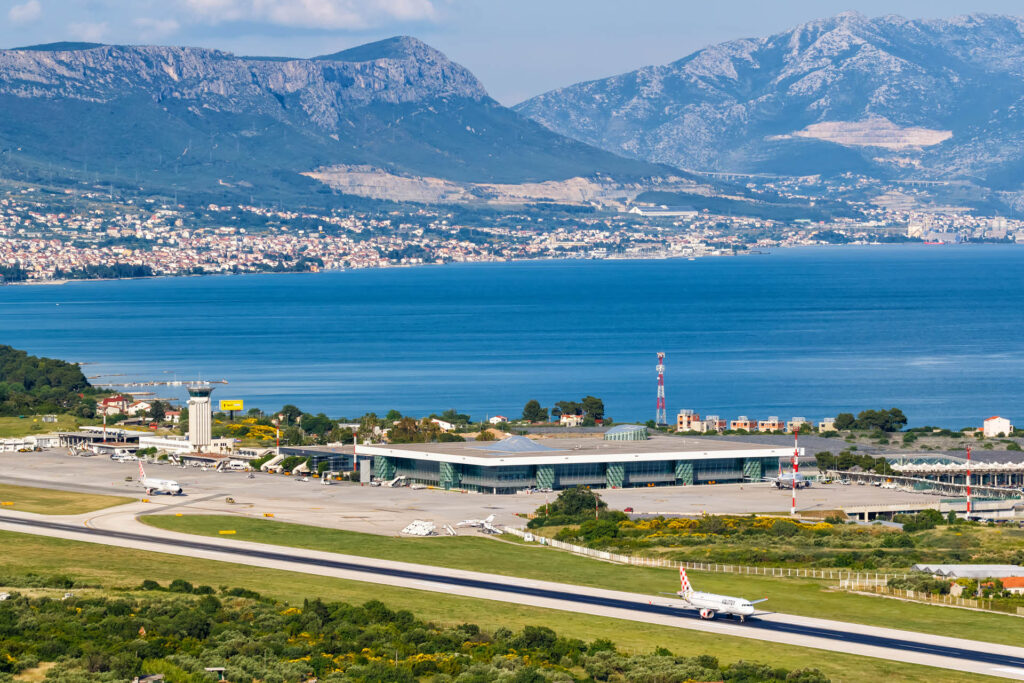
- Your journey begins at Split Airport, located approximately 6 kilometers west of Trogir.
- The airport is well-connected to major European cities, offering both domestic and international flights.
Travel tips:
2.1 Taxi from airport to Trogir
- Taxi: Taxis are readily available at the airport, providing a convenient and quick transfer to Trogir. The journey takes around 6-10 minutes depending on traffic. Wait time is no longer than 5 minutes.
- Shuttle Service: Shared shuttle services operate from the airport, offering cost-effective transportation to Trogir. Ensure to check the schedule and availability in advance.
- Taxis, including Uber and Bolt services, are readily available at the airport, providing a convenient and quick transfer to Trogir. Both Uber and Bolt are popular ride-sharing options with transparent pricing.
- Domestic taxi companies such as Cameo and Yellow Taxi also operate from the airport and can be accessed through Google Play apps. They offer affordable rates, comparable to those of Uber.
- It’s worth noting that most tourists commonly prefer and use Uber and Bolt due to their widespread popularity and user-friendly interfaces.
- Split city taxi is available but tends to be much more expensive, so we strongly recommend considering Uber, Bolt, or Cameo for a cost-effective and reliable journey.
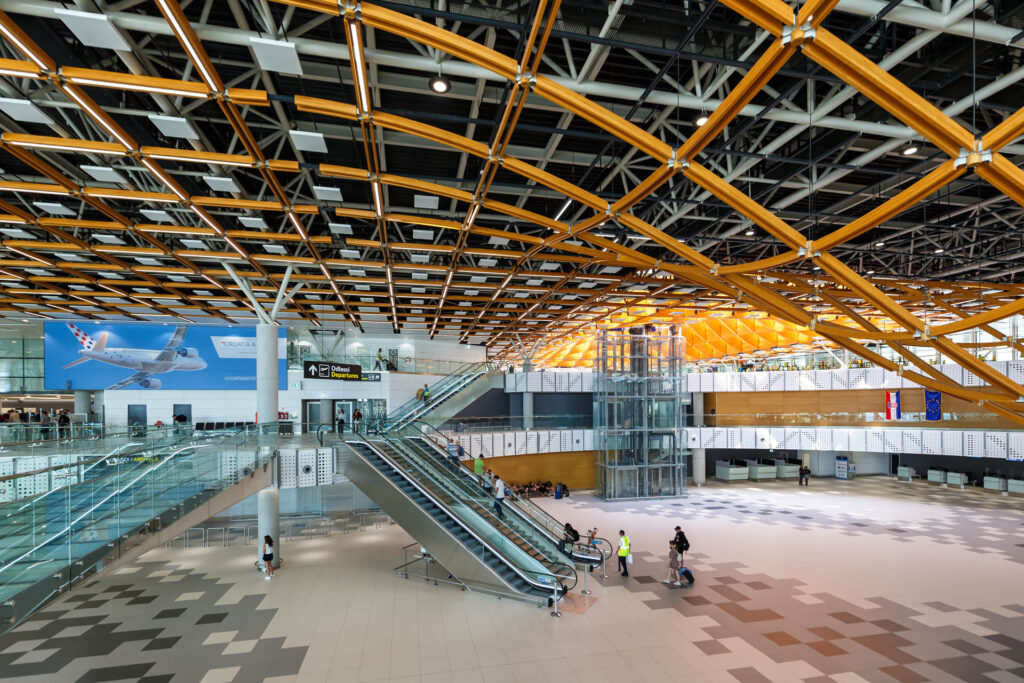
Travel from Split airport to Trogir:
DISTANCE FROM SPLIT AIRPORT TO TROGIR
6 km (3.7 miles) west
ESTIMATED TRAVEL TIME TO TROGIR
Around 7 minutes by taxi
2.2 Car rental
For those preferring flexibility, car rental services are available at Split Airport. Rental agencies offer various vehicle options to suit your needs. Renting a car also allows you to explore nearby places such as Split, Brela, Makarska, Primošten, Krka National Park, Zadar and Šibenik. Explore various car rental companies to find the best prices and services available.
2.3 Public Transport (Bus)
Bus: Local buses and airport shuttles connect Split Airport to Trogir and its neighboring areas. The bus journey typically takes around 10 minutes, providing an economical transportation option.
For convenient transportation to and from the airport, the local bus service offers regular routes:
- Bus Line Number 37 runs along the main road connecting Trogir to Split and vice versa. Departures occur every 20 minutes on weekdays and Saturdays, with a slightly adjusted frequency of every 30 minutes on Sundays. A one-way ticket to Split is priced at 3 EUR, while a one-way ticket to Trogir costs 2.5 EUR.
- Bus Line Number 38 serves routes connecting Split to Kastel Stari and Resnik, as well as Resnik to Kastel Stari and Split.
ESTIMATED TRAVEL TIME TO TROGIR
Around 10 minutes by bus
ESTIMATED TRAVEL TIME TO SPLIT
Around 30 minutes by bus
A shuttle airport bus is a service that provides transportation between an airport and designated locations, such as city centers, hotels, or other key destinations. Unlike regular public buses, airport shuttle buses often operate on a specific schedule and may have fewer stops, providing a more direct and efficient connection between the airport and popular destinations. Passengers usually pay a set fee for the shuttle service, and reservations may be required in advance, depending on the specific service provider. Connecting the airport to Trogir and Split main bus station, the shuttle service is managed by Pleso Prijevoz. The bus schedule may vary based on the season.
Typically, the bus departs from the airport 30 minutes after the arrival of scheduled flights, while from the main bus station, it leaves approximately 2 hours before the departure of scheduled flights.
2.4 Arrival in Trogir
Once you arrive in Trogir, you’ll find yourself in a charming historical town with a rich cultural heritage, inviting you to explore its narrow streets, ancient architecture, and vibrant waterfront.
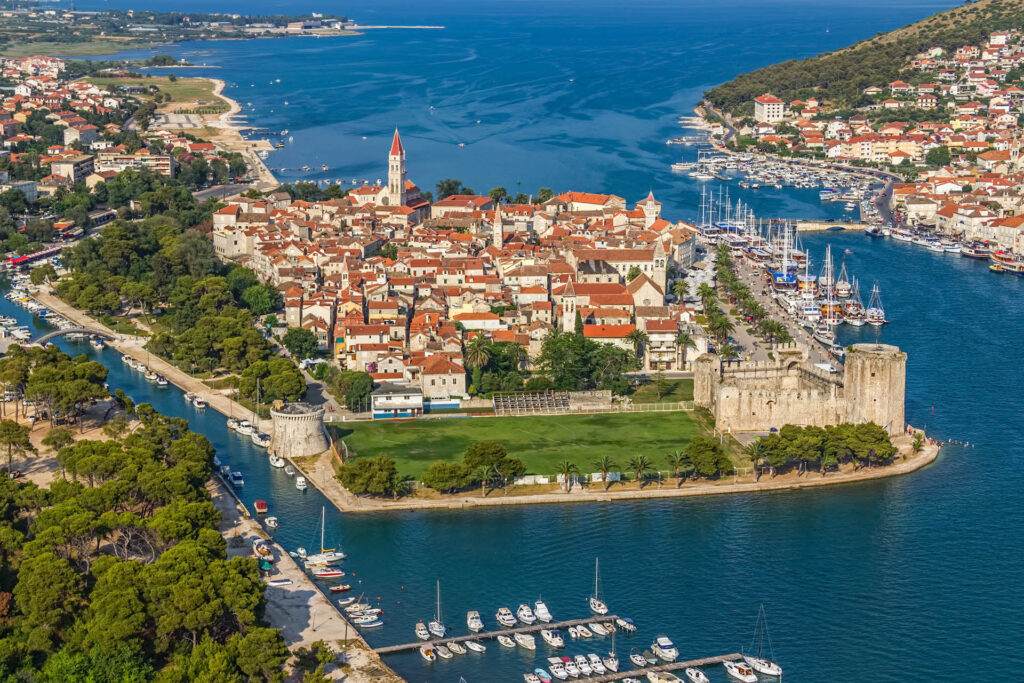
Arriving by airplane to Trogir ensures a seamless transition from the airport to the town, allowing you to swiftly embark on your exploration of this captivating Croatian destination.
Arrival Tips: We recommend taking Uber or Cameo to Trogir, as the cost will be affordable (around 10 EUR), and it will take you directly to your hotel or apartment location. Another option would be to rent a car, but in that case, you might want to consider renting it for more than a day.
3. Arriving in Trogir by car
Navigation Apps: Use navigation apps such as Google Maps to guide you through the most efficient route. Ensure your GPS is updated with the latest maps.
Travel Documents: Carry your valid driver’s license, vehicle registration, and any necessary international permits. Check if there are specific requirements for driving in each country you’ll pass through.
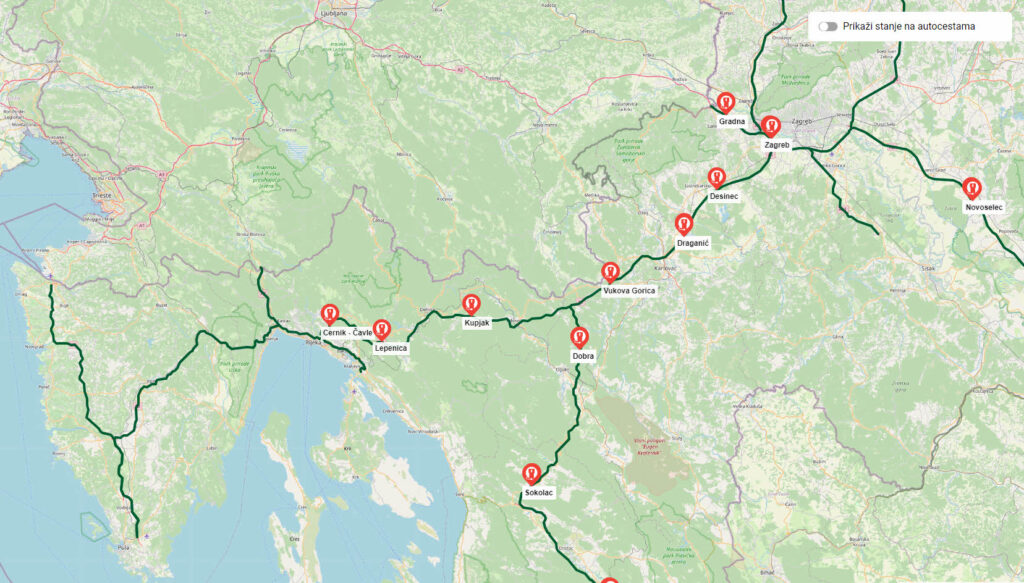
The most common and efficient route from the Croatian border (near Zagreb) to Trogir is usually taking the A1 highway. Here are the general directions:
Assuming you have crossed the border and are near Zagreb, begin by following signs for the A1 highway.
- Take the A1 Highway (Autocesta A1): The A1 is the main highway connecting Zagreb to the Adriatic coast. It’s a toll highway, so be prepared for toll booths along the way.
- Head South: Follow the A1 southbound, passing through cities like Karlovac, Gospić, Zadar, Šibenik, and continuing towards Split.
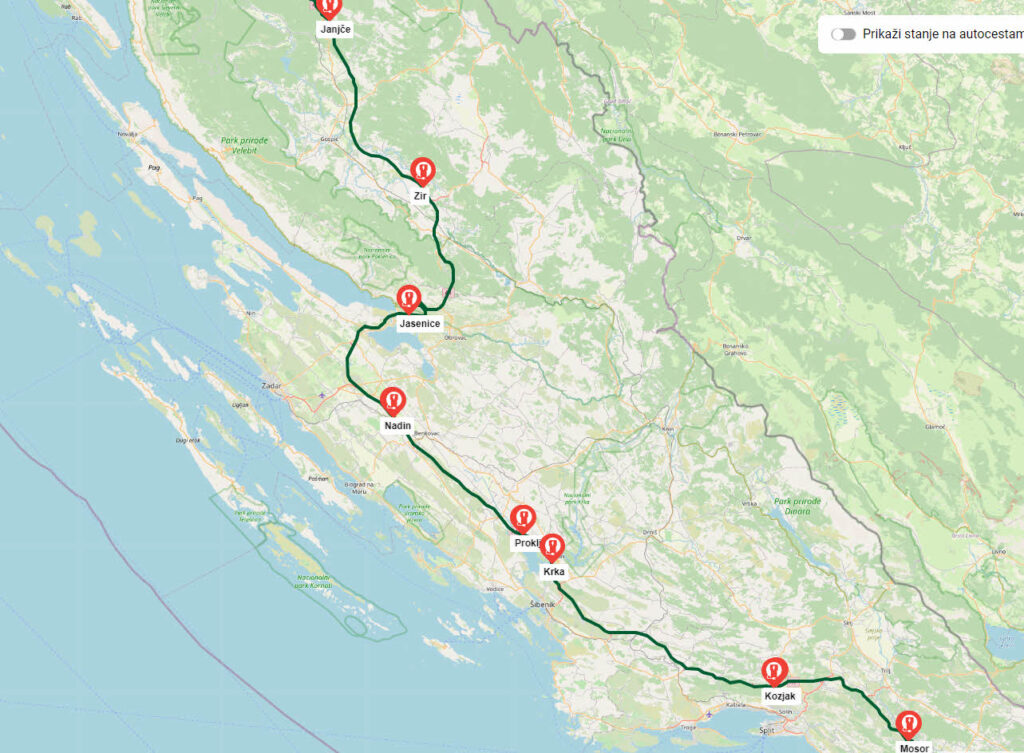
- Exit for Trogir: As you approach Split, you’ll see signs for Trogir. Take the appropriate exit to connect to the D8 road, which leads directly to Trogir.
- Follow Signs to Trogir: Once on the D8 road, follow signs directing you to Trogir. The road will lead you to the bridge connecting the mainland to Trogir.
Road Conditions: Check the road conditions, especially if you’re traveling during winter when weather conditions can impact driving.
Parking in Trogir: Once you arrive in Trogir, find secure parking near your accommodation. Some hotels may offer parking facilities.
4. Arriving in Trogir by Bus
Traveling to Croatia by bus offers a convenient and scenic journey, typically along the well-maintained highways of the country. Here are some key points to consider:
- Highway Routes: Buses often take advantage of Croatia’s extensive highway network, ensuring smoother and faster travel between cities and regions.
- Comfort and Amenities: Modern buses in Croatia are equipped with comfortable seating, air conditioning, and other amenities for a pleasant journey.
- Bus Stations: Major cities and tourist destinations in Croatia have central bus stations where intercity buses arrive. These stations are well-connected to local transportation for further travel.
- Ticketing and Reservations: It’s advisable to book bus tickets in advance, especially during peak travel times. Online platforms or local bus companies can assist with reservations.
- Travel Time: Travel times may vary depending on the distance and route. Buses offer the opportunity to enjoy the picturesque landscapes of Croatia along the way.
- City Connections: Buses provide a convenient mode of transport for exploring various cities and regions within Croatia. Local buses or taxis are usually available upon arrival at your destination.
- Bus Operators: Different bus companies operate both domestic and international routes to and from Croatia. Choose a reputable operator for a reliable and comfortable journey.
5. How to find Parking in Trogir
When it comes to parking in Trogir, there are many options available.
On-street Parking:
Trogir’s old town is a pedestrian zone, and cars are not allowed inside its narrow, cobblestone streets. However, there are on-street parking spaces available just outside the old town area. These spaces are usually marked and require payment, either at parking meters or through mobile apps.
Parking Lots:
There are dedicated parking lots in Trogir, both within walking distance of the old town. These parking areas are convenient for visitors who prefer to leave their cars in a secure location and explore the town on foot. Parking fees are typically reasonable, and some lots offer daily rates.
There is a parking lot in downtown called Fortin Parking Lot. The municipal Fortin parking lot, situated in the Hrvatskih mučenika i Hrvatskog proljeća 1971 street within the old town core, is designated for the parking of personal vehicles. Free parking is allowed for up to 20 minutes from the time of entry. Payment is applicable throughout the year on a 24/7 basis.
Parking Lot Travarica (T1)
The municipal parking lot Travarica (T1) is an outdoor facility located along the southern edge of Alojzija Stepinca street, adjacent to the Trogir – Šibenik highway. This parking lot is designated for the parking of personal vehicles. Free parking is allowed for up to 10 minutes from the time of entry.
Parking Lot Put Kapelice (T2)
The municipal parking lot Put Kapelice (T2) is an enclosed outdoor facility situated along the eastern and western edges of Put Kapelice street, designated for the parking of personal vehicles. Free parking is permitted for up to 10 minutes from the time of entry.
Parking Lot Brigi (T4)
The municipal parking lot Brigi (T4) is a closed outdoor facility situated along the southern edge of Knez Trpimira street, designated for the parking of both personal vehicles and buses. Free parking is allowed for up to 10 minutes from the time of entry. This parking lot is a bit farther from downtown compared to other parking facilities, approximately 700 meters away.
Here is a comprehensive overview of the available parking lots in Trogir.
Parking Tips: We recommend parking your car in Parking Lot Travarica (T1) as it offers ample available parking spaces.
If you’re staying at a hotel or other accommodations in Trogir, check with them about parking options. Many hotels provide private parking spaces for their guests. This can be a convenient and secure choice, especially if you plan to stay overnight.
Plan Ahead: During peak tourist seasons, parking in popular destinations like Trogir can be challenging. It’s advisable to arrive early to secure a parking spot, especially if you plan to spend the day exploring the town.







